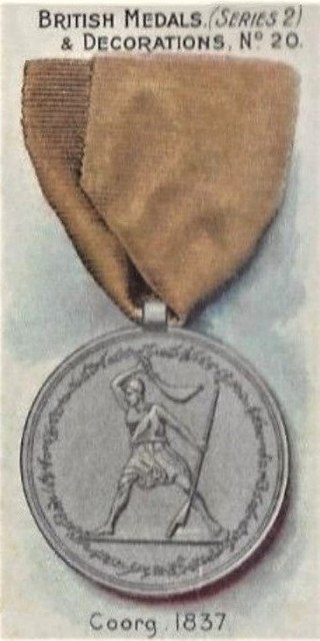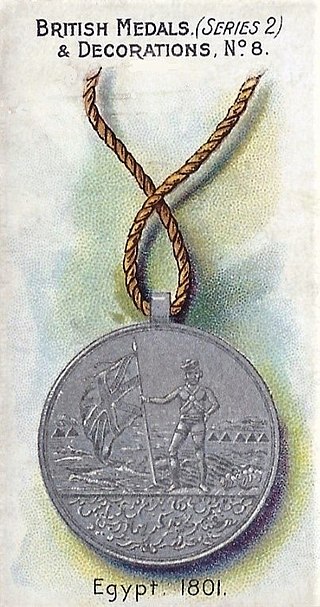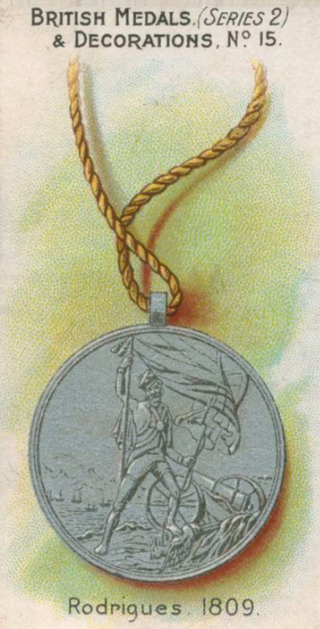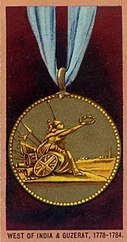
Tipu Sultan, also known as the Tiger of Mysore, was the Indian Muslim ruler of the Kingdom of Mysore based in South India. He was a pioneer of rocket artillery. He introduced a number of administrative innovations during his rule, including a new coinage system and calendar, and a new land revenue system, which initiated the growth of the Mysore silk industry. He expanded the iron-cased Mysorean rockets and commissioned the military manual Fathul Mujahidin. He deployed the rockets against advances of British forces and their allies during the Anglo-Mysore Wars, including the Battle of Pollilur and Siege of Srirangapatna.

The Military General Service Medal (MGSM) was a campaign medal approved in 1847 and issued to officers and men of the British Army in 1848.

The India General Service Medal was a campaign medal approved on 1 March 1854, for issue to officers and men of the British and Indian armies. It was awarded for various minor military campaigns in India and nearby countries, between 1852 and 1895.

The Indian General Service Medal was a campaign medal approved on 1 January 1909, for issue to officers and men of the British and Indian armies. From 1919, it was also awarded to officers and men of the Royal Air Force, with the Waziristan 1925 clasp awarded solely to the RAF.

The Indian General Service Medal was a campaign medal approved on 3 August 1938, for issue to officers and men of the British and Indian armies, and of the Royal Air Force.

The Army of India Medal (AIM) was a campaign medal approved in 1851 for issue to officers and men of the British Army and the Army of the Honourable East India Company. A retrospective award following the precedent set by the Naval General Service Medal and the Military General Service Medal, it served to reward service in various actions from 1803 to 1826.

The India Medal was a campaign medal approved in 1896 for issue to officers and men of the British and Indian armies.

The Sea Gallantry Medal (SGM), is a United Kingdom award for civil gallantry at sea.

The Seringapatam Medal, or Sri Ranga Pattana, is a campaign medal that was awarded by the Governor-General of India to all British and Indian soldiers who participated in the British victory in the Battle of Seringapatam in 1799.

The Jellalabad Medal was a campaign medal issued by the British East India Company. It was established by Lord Ellenborough, the Governor-General of India, on 30 April 1842.
The medal was awarded for the defence of Jalalabad from 12 November 1841 to 7 April 1842, during the First Afghan War, to the troops under the command of Sir Robert Sale. About 2,600 soldiers took part, including the 13th Foot, the 35th Bengal Native Infantry, as well as detachments from other Indian Army units and some loyal Afghan forces.

Coinage under British governance of the Indian subcontinent can be divided into two periods: East India Company (EIC) issues, pre-1835; and Imperial issues struck under direct authority of the crown. The EIC issues can be further subdivided into two subcategories: the Presidency issues, which comprise separate Madras Presidency, Bombay Presidency, and Bengal Presidency issues; and uniform coinage for all British territories from 1835 to 1858. Imperial issues bear obverse portraits of Queen Victoria, Edward VII, George V, and George VI. No British India coins were issued during the brief reign of Edward VIII.
The Indian Police Medal (IPM) was an award of the British Raj presented to both European and Asian police personnel. Established in 1932, the award was presented for meritorious service and gallantry that was of a lesser degree than what was required for the King's Police Medal.

The Capture of Ceylon Medal is a campaign medal that was awarded by the Governor-General of India to soldiers in Bengal artillery units of the armies of the East India Company (EIC) who took part in the capture of Ceylon in 1795–96.

The Java Medal is a campaign medal awarded by the Governor-General of India to soldiers of the armies of the Honourable East India Company (HEIC) who participated in the Invasion of Java in August and September 1811, during the Napoleonic Wars.

The Nepal Medal was awarded by the Honourable East India Company (HEIC) to native Indian officers, and Indian soldiers for particularly distinguished conduct, during the Anglo-Nepalese War of 1814–16.

The Burma Medal is a campaign medal awarded by the Governor-General of India to native Indian soldiers of the armies of the Honourable East India Company (HEIC) who participated in the First Burma War from April 1824 to February 1826.

The Coorg Medal was awarded by the Honourable East India Company (HEIC) to local forces who remained loyal during the Coorg rebellion of 1837.

The Mysore Medal is a campaign medal that was awarded by the Governor-General of India to native Indian soldiers of the armies of the Honourable East India Company (HEIC) who participated in the Third Anglo-Mysore War of 1790 to 1792.

The Egypt Medal is a campaign medal that was awarded by the Governor-General of India to members of the expeditionary force that travelled from India to take part in the 1801 Egyptian campaign, a part of the French Revolutionary Wars.

The Medal for the capture of Rodrigues, Isle of Bourbon and Isle of France is a campaign medal that was awarded by the Governor-General of India to native Indian soldiers of the East India Company (EIC), who took part in the capture of these three Indian Ocean islands from French forces between July 1809 and December 1810.




















